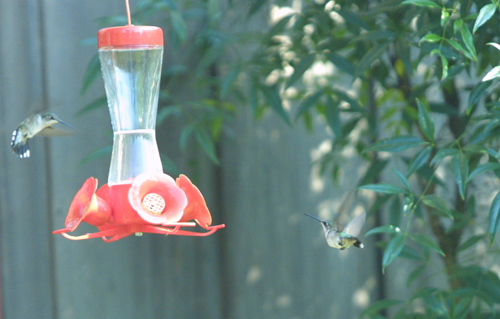Hummingbirds will soon make their way back to Georgia after wintering in Central America. Welcome them to your house by providing their favorite plants and the right food in the right places.
Attract and maintain
"Think like a hummingbird," said Paul Thomas, a floriculture specialist with the University of Georgia Cooperative Extension.
They spend a great deal of their life in the tropics living in the tree canopies. Providing them a similar habitat will increase the chances of them setting up housekeeping in your backyard. Remember, they can be spotted as late as January in some areas. They usually return in March.
If a male hummingbird sees the native plant horse chestnut, or Aesculus glauca, he knows the area is suitable habitat. Males are attracted to bright-red flowers like those on Lonicera sempervirens, or the native honeysuckle.
Later in the summer, babies prefer flowers such as Salvia guaranitica, or blue sage, which are blue. Planting a variety of flowers that provide nectar all summer long will give them a nice area for breeding.
Other recommended plants are red flowering chestnut, abelias, summer phlox, chaste tree, columbine, cardinal flower, bee balm, red hot poker, hibiscus and most salvias.
In addition to planting appropriate flowers, provide stable artificial nectar sources. "Have a feeder present and ready during migration, or they will fly right by," Thomas said.
Place a few feeders in the open for males, but put twice as many in the tree canopy for females. "That way the females don't have to compete with the males for food and then are usually very successful at raising a new brood," he said.
Female hummingbirds naturally look for wooded areas near nectar sources for nesting.
Nests are usually found between 12 and 18 feet above the ground. Feeders should be placed this high from the ground just inside the canopy.
Take a wire shaped in an "s" and hang it on a tree branch. Attach a large wire loop to the feeder for easy hanging. Use a pole with a coat hanger hook to hang it, he said.
Put a shallow ceramic bird bath with a water level less than half of an inch at any time five to six feet off the ground in full sun, too.
Feeder etiquette
A sugar solution made of four parts water and one part table sugar is the best mix to put in feeders. The mix should be boiled for a few minutes and then cooled. Never add fruit juice, honey or red dye. Hummingbirds get their daily protein from eating gnats and tiny flies, so they really don't need any extra in the nectar solution.
Feeders should be kept up year round in Georgia. Birds will leave an area where feeders are not maintained. "A clean feeder is a welcome sight to hummingbirds," Thomas said.
Feeders should be cleaned every two to three days. Insects introduce bacteria to them. This can sicken or kill the birds. To limit this problem, only fill feeders half way and replace solution every other day.
To clean feeders, dump the leftover food. Wash thoroughly by rinsing three or four times before refilling. If really dirty, place feeders in boiling water for a few minutes. Never use bleach.
"You have to be a good steward with feeders, so be very consistent, and your hummingbirds will reward you with a healthy population and many more birds that return each year," Thomas said.








